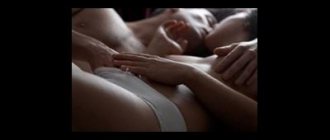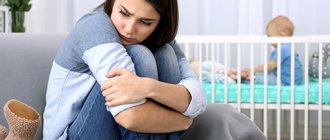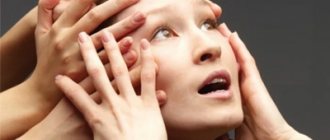Fear of closed spaces is not an absolute limitation to the use of magnetic resonance imaging. If indicated, MRI is performed in patients suffering from claustrophobia and fear of the procedure. The diagnostic value of the study justifies the possible discomfort during scanning. The method is highly informative and allows you to visualize internal structures without invasive manipulation.
MRI of the head, images in coronal and sagittal projections
The method is based on the use of a magnetic field that is safe for human health. Under the influence of a directed pulse, the hydrogen atoms in water molecules change position. The resonance of charged particles allows you to obtain a stable signal, which is recorded using a special detector and converted into layer-by-layer photographs. To improve the quality of the examination, you must remain still during the scan. Changing body position provokes the appearance of artifacts in photographs.
What is claustrophobia?
The name of the disorder comes from the Latin word claustrum - “closed room” and the Greek φόβος - “fear”. However, claustrophobia is not limited to the fear of closed spaces. Thus, anxiety may well overtake a person suffering from claustrophobia in a spacious and bright room if something there restricts his freedom of action. It is not uncommon to experience panic attacks in the hairdresser's chair or while a manicurist is working. In some severe cases, even tight, tight-fitting clothing can cause a feeling of danger.
All claustrophobes tend to avoid “dangerous” places, even if it is to their own detriment. Surely you know a couple of people who, out of fear, will refuse any elevator rides. Even when exhausted from heat or fatigue, they will walk ten floors just to avoid getting into that terrible elevator. Some people refuse an MRI procedure due to an unbearable fear of the CT scanner.
In general, people suffering from claustrophobia are forced to significantly limit their living space. Much of what is accessible to “ordinary” people: elevators, subways, basement floors, tunnels, etc., becomes inaccessible to them.
According to statistics, 15-37% of people on the planet suffer from a phobia of closed spaces []. However, many claustrophobics are ashamed of their “strange” fears. Therefore, only a few find the courage to turn to psychologists or psychotherapists to treat claustrophobia.
Symptoms
Symptoms of pathology vary depending on the individual mental characteristics of a person. In each specific case, claustrophobia manifests itself in its own way.
The main signs of the disorder are fear of suffocation and fear of restriction of freedom.
These are usually added to:
- cardiopalmus;
- sense of anxiety;
- dyspnea;
- profuse sweating;
- dryness and sore throat;
- cough;
- feeling of near death;
- fog;
- weakness;
- nausea;
- labored breathing.
Usually an attack of phobia is accompanied by a desire to get a breath of fresh air, to rip off clothes. All of these symptoms disappear when the cause of the fear is eliminated. A person may feel the consequences of an attack for several days.
Today you can independently identify the signs of claustrophobia. To do this, it is enough to pass a special test , which will show the level of disposition to the disorder.
Signs and symptoms of claustrophobia
First of all, you must understand that symptom and sign are similar, but not equivalent concepts. A symptom is what the patient suffering from the disease describes. A sign is something that is observed by a psychologist, doctor, or others.
For example, a symptom of claustrophobia may include a feeling of chills or a feeling of derealization while moving on a subway escalator. A sign of fear of confined spaces will be fussiness in movements and paleness of the skin.
As we have already said, claustrophobia is an anxiety disorder. Therefore, the symptoms of claustrophobia are the physical and emotional manifestations of anxiety. It is not necessary to be in a frightening place or situation for symptoms to appear; sometimes just thinking about the need to go there is enough. Sometimes such thoughts become obsessive, and frightening images rush into your head, for example, those associated with being stuck, being buried alive, etc.
Here is a list of typical situations that cause fear in patients with claustrophobia :
- elevators of residential buildings and supermarkets;
- metro;
- tunnels;
- some medical devices, such as MRI;
- trains;
- cars, especially with central locking;
- car washes (automatic);
- aircraft;
- locked rooms;
- small rooms;
- rooms where there are many people (for fear of suffocation from lack of oxygen in the air);
- rooms without windows;
- basements and cellars.
Since claustrophobia is also considered a phobia of being limited in something, constrained in actions, then the following should also be added to the listed places:
- queues at the cash register;
- hairdressers;
- massage rooms;
- public transport following a strict route;
- traffic jams during rush hours.
The most common symptom of claustrophobia is a feeling of lack of air or the inability to take a full breath . What is typical is that sometimes it appears even before a person feels a clearly expressed emotion of fear.
Typical physical symptoms of claustrophobia:
- palpitations sometimes accompanied by chest pain;
- increased blood pressure;
- nausea;
- headache or dizziness;
- derealization or feeling of disorientation;
- I really want to go to the toilet;
- shiver;
- increased sweating, makes you feel hot (or, conversely, cold);
- dry mouth.
It is quite easy to recognize a person who is experiencing an attack of claustrophobia, since there are noticeable behavioral signs of fear of closed spaces :
- check rooms for exits and whether windows open. They are often asked not to close at least one door. If there is a need to close all the doors, they begin to become noticeably nervous, even to the point of “escape”;
- at crowded events, even in well-ventilated and large rooms, they still take a place closer to the door;
- do not lock the hotel door when they are indoors;
- never use the elevator, even if you need to go to the upper floors;
- Avoid driving on the road during hours when traffic is heavy and a traffic jam is likely.
Why does claustrophobia occur?
Most human fears are based on situations that pose a threat. Fear is a modified instinct of self-preservation. Let's try to figure it out, claustrophobia, what is it according to the theory of evolution? Fear is a kind of protective element that warns against participation in potentially dangerous situations. The ancestors were afraid of closed spaces and risked moving through narrow underground passages and caves due to the possibility of collapse. Experiences at the genetic level were transmitted to modern representatives of humanity.
The second risk factor is disruptions in brain function. Testing confirms that in people suffering from claustrophobia, this is manifested by a decrease in the right amygdala, which is responsible for the production of positive and negative emotions. The frontal nuclei send impulses to other limbic compartments, accelerating the heartbeat, causing shortness of breath.
Childhood psychotrauma suffered in closed spaces is associated with a risk of developing the disorder in question. Memories can be erased, but in the subconscious they give rise to hidden emotions: worry about one’s life, hopelessness syndrome. The body repeats the situation if the environment reminds of what it experienced in the past. There are known cases of claustrophobia occurring after trauma in adulthood. For example, among miners or speleologists who survived landslides.
Overly suspicious parents risk developing a fear of closed spaces in their children. This is due to constant warnings that the elevator is dangerous, the closet is dark, the basement is cold. The logical meaning of phrases is lost over time; the adult personality simply remains with the subconscious confidence that closed spaces are unsafe.
Claustrophobia is sometimes caused by a thirst for discovery or dramatic change. Scientists have found that people with this disease have a powerful character, are active and inquisitive by nature. Their brain requires productive activity, is aimed at discovery, and is critical of stability.
Individuals with the opposite of claustrophobia, agoraphobia, prefer comfort and have a negative attitude towards change. Individuals’ fears manifest themselves on the streets, markets and other crowds of people. It is not entirely correct to say that this diagnosis is the antithesis of the fear of closed spaces.
Causes of fear of enclosed spaces
Psychologists agree that the foundation of claustrophobia in an adult is formed in childhood, less often in adolescence. As a rule, patients easily recall situations from childhood where they had to experience severe fear and even panic.
A list of situations from childhood that can cause claustrophobia:
- school jokes when someone is locked in the toilet;
- getting stuck in an elevator with a long wait for emergency services;
- parents forgot to pick up from kindergarten, stress and anticipation of their arrival in a small room;
- cases of exhaust gas poisoning on a bus or car;
- swimming in a pool or lake (especially with opaque water) if you are unable to swim and have episodes of drowning;
- getting stuck in pipes, fences, beds during children's games.
And especially impressionable people do not have to be a participant in the listed events.
It's enough to watch someone else for a while. Regularly published information in the media about accidents that occurred in such places, watching horror films, reading scary stories about being buried alive - all this can excite the imagination so much that the seeds of fear sprout abundantly in the form of claustrophobia. We discussed this mechanism in detail in the article on phobias. There are studies that convincingly show the transmission of claustrophobia symptoms “by inheritance” []. In other words, if a father or mother has complaints of claustrophobia, then the child is highly likely to follow in the footsteps of the parent suffering from neurosis.
As you can see, claustrophobia includes childhood psychological trauma . This means that the neural circuit in which this fear is “stored” is located in the “childish” part of the brain, i.e., one that is poorly controlled by the “adult” rational mind. This is why people who suffer from elevator phobia, are afraid to use the subway, or who avoid locked rooms are often well aware that their fears are unfounded, but they just can’t do anything about it.
In adulthood, claustrophobia can develop as a result of a panic attack experienced in a confined space (for example, with somatoform nervous disorders or, as many call it, VSD, vegetative-vascular dystonia).
Why does not all people develop claustrophobia, because many had to swallow water in a swimming pool as a child, get stuck in an elevator, etc.?
Perhaps the answer to this question lies in physiological predispositions. Thus, it was found that people with symptoms of anxiety-phobic disorders, incl. claustrophobia, have on average smaller amygdalae [].
The amygdala is an amygdala-shaped area of the brain that is responsible for the formation of fear and some other emotions.
There is also a hypothesis about the existence of a certain gene for claustrophobia, but there are too few reliable publications on this topic.
Causes of the disorder
It is believed that the cause of fear of enclosed spaces may be mental trauma received in childhood or in emergency situations (such as a fire); A person’s weak psyche is also a risk factor.
This is the classic explanation for the causes of claustrophobia. There are studies in which the majority of claustrophobics surveyed confirmed that the disorder appeared in them after negative experiences in childhood (and sometimes in adulthood).
These negative experiences can manifest themselves in different ways.
:
- A person was often locked in a dark and cramped room, in a box or in a closet.
- The child fell into the pool and could not swim.
- A child lost his parents while in a large crowd.
- The child stuck his head between the fence bars and could not get out.
- The child fell into a hole and cannot get out.
- A child gets lost in the forest and cannot find a way out.
- The child was left alone in a locked car.
- The child is in a crowded place without windows. Or the place where he ends up as punishment (for example, in the basement).
It is important that the situation is repeated repeatedly, then the brain establishes a certain connection between the situation and the consequence. In the future, when getting into similar situations, a person begins to experience fear “in advance”, because his brain expects certain consequences (impossibility of getting out, lack of air, being without food and water for a long time).
Some researchers even show that past experiences can occur at the time of a person's birth. The baby receives a birth injury, which subsequently becomes the cause of a fear of confined spaces.
Claustrophobia may thus be inherited by humans from ancient animal ancestors. They lived in a much more dangerous world than we do now, and the ability to quickly get out of a trap was an essential factor for survival. Modern humans usually do not have such a need, but our brain has not yet been able to completely restructure itself, as a result of which some people experience such ancient behavioral reactions.
There are, however, studies that link the onset of claustrophobia to dysfunction of the amygdala. This organ is one of the smallest parts of the brain, but it is also one of the most important. The amygdala is used to generate fear and the fight-or-flight response. Researcher Fumi Hayano found that in patients suffering from claustrophobia, the right amygdala in this organ is noticeably smaller in size than normal. This may be the true reason for the formation of the disorder: a “damaged” amygdala sends excessive signals of anxiety when a person finds himself in certain situations.
Thus, a “mental” disorder can be explained by a completely material reason - the abnormal development of the amygdala.
Psychologists, in turn, believe that the presence of personal space for each person plays a certain role in the development of fear of enclosed spaces. This is a kind of abstract buffer zone, when an outsider enters it, he begins to feel discomfort. The size of our personal space may be different for each of us; According to experts, the larger it is, the higher the likelihood of developing claustrophobia.
There is even “hereditary” claustrophobia: this disorder can be observed in several generations of the same family. This is explained both by the similar character and mental organization of close relatives, and by children’s observation of the behavior of their parents, brothers and sisters. When one of the parents in the family suffers from claustrophobia, the children observe his behavior and from this example they learn what to be afraid of in life. They subsequently pass this knowledge on to their children. According to this principle, claustrophobia can be transmitted not only between relatives, but also between peers and in general between any people who often communicate and share their life experiences with each other.
Claustrophobia can also occur, for example, when watching a horror film in which the characters are locked in a small space. Here, according to scientists, ancient behavioral models embedded in genes are again activated: our body is initially programmed by nature to be afraid of certain dangerous situations. Constantly observing such situations can lead to the development of a mental disorder.
A curious observation, although sad, was made of the miners. A team of 21 miners spent a long time underground, and during this time six of them died from suffocation. The rest remained alive, were rescued and were examined by specialists for ten years. Their mental state has been steadily deteriorating over the years; many developed claustrophobia, which had not been noted before. Only one miner from this team did not experience a significant deterioration in his condition; it was the team leader.
Is it possible to diagnose claustrophobia yourself?
In general, other neuroses have symptoms very similar to claustrophobia. For example, panic disorder, agoraphobia (yes, it is true, despite the opposite meaning in the name!), bladder neurosis, social phobia, etc.
What emotions do you experience when looking at this drawing?
Each problem has its own specific treatment, so it is advisable that the diagnosis be carried out by a psychiatrist, psychotherapist or psychologist who specializes in working with similar problems. Otherwise, therapy may be ineffective!
However, you can click on the link to test yourself for the presence and level of claustrophobia without contacting a specialist in the appropriate field.
Diagnosis of manifestations of phobia
Fear of closed spaces must be distinguished from other manifestations of a similar plan - lack of confidence in one’s abilities, modification of some personality traits, depressive, paranoid processes.
Psychological and physical signs of claustrophobia:
- twitching and unpleasant coldness in the limbs;
- rapid breathing;
- tachycardia;
- migraine;
- fear of suffocation, inability to leave the room, ability to control oneself;
- fear of situations that provoke attacks;
- pallor or redness of the skin;
- lack of coordination;
- an active state of anxiety or entering a stupor.
Claustrophobia is diagnosed using the Spielberger-Hanin test. The client chooses one of four versions of the answer to the tasks. The results are calculated using a special key. A score above 45 points indicates a risk of developing an illness; from 75, panic attacks are added to attacks of claustrophobia.
Establishing a diagnosis using MBK-10
This disorder occurs if all of the following symptoms are met:
- there is anxiety, accompanied by psychological or vegetative manifestations;
- delusions or intrusive thoughts are not the primary causes of anxiety expression;
- stress is activated only in a confined space or a huge crowd of people;
- There is a moderate avoidance of processes that contribute to the development of fear.
After the examination, a diagnosis of F40.00 or F40.01 is made (phobia without/with panic manifestation).
About the treatment of claustrophobia
As in the treatment of other neuroses, in order to get rid of claustrophobia, you can use the following ways to solve the problem.
Drug treatment . This type of therapy may temporarily help manage anxiety symptoms. And although most people suffering from claustrophobia want to start with pharmacotherapy, the doctor should make every effort to explain this important point to the patient. The pills do not affect the root of the problem, and, in addition to side effects, after stopping the course of treatment, a relapse (i.e., return of fears) is more than likely. Phobia experts agree that medications should only be used if other attempts to solve the problem have failed [].
Relaxation techniques . This should include breathing exercises, progressive muscle relaxation according to Jacobson, and meditative techniques. Relaxation techniques can help you cope with claustrophobia on your own if the level is not very severe. However, we would separately highlight autogenic training (autotraining), which, with due persistence, can help overcome almost any neurosis.
Psychotherapy for claustrophobia . This is a more expensive remedy than drug treatment. However, if the psychologist is sufficiently qualified in the treatment of anxiety disorders, then the effectiveness of such intervention will be very high. There are generally accepted psychotherapeutic methods for treating claustrophobia. These include strategic psychotherapy, cognitive behavioral therapy, EMDR therapy or EMDR (especially effective if the disorder is based on childhood fears), and hypnosis. Such popular methods as Gestalt therapy, psychoanalysis and others related to the conversational genre are less effective [, , ].
Traditional methods (alternative medicine) . It is said that some people have been able to recover from claustrophobia thanks to some natural products as well as homeopathy. Unfortunately, we can neither confirm this information nor refute it. However, as for homeopathic medicine, there are serious studies proving that it is nothing more than a placebo [].
We know that many of our readers are in search of a simple and extremely effective cure for claustrophobia and other psychological problems. Well, we probably have such a remedy! Watch the video of the fastest way to overcome the fear of closed spaces (the heroine of the video wants to get rid of the fear of being buried in a box, which manifests itself in the form of a fear of MRI machines; she cannot be in any room without windows, the subway, etc.).
/wp-content/uploads/best-claustrophobia-treatment.ogv
We hope you get the joke. If this method does not suit you, but you really want to get rid of the symptoms of claustrophobia and live a free, happy life, we, specialists, will be happy to help you! After all, claustrophobia is curable, and much easier than many people think!
Diagnostics
Don't try to diagnose claustrophobia yourself. After all, to choose the optimal treatment method, it is necessary not only to establish the fact of the disease, but also to determine the degree of development of the phobia.
More than 9,000 people have gotten rid of their psychological problems using this technique.
A psychologist will be able to identify psychological and physiological signs of claustrophobia during a conversation in a comfortable environment for the patient.
Special questionnaires will help determine the degree of development of the disease. The Reactive and Trait Anxiety Scale will reveal a person’s level of anxiety. And the questionnaire method developed by Rahman and Taylor will determine the symptoms of claustrophobia. The effectiveness of these methods has been proven by practical research.
Treatment
Photo: clinicist.ru
Treatment of claustrophobia is a long process that requires a lot of patience from the patient. First of all, psychotherapists work with people suffering from claustrophobia, who, in addition to their classes, can prescribe medications that reduce anxiety.
Psychotherapy is carried out both individually and in group form. The choice depends on the severity of the disorder and the person’s personality. It is believed that individual sessions are the most effective, allowing to build a trusting relationship between the patient and the doctor, which leads to the accelerated achievement of the desired effect.
The psychotherapist is aimed at finding the cause of claustrophobia. Research has shown that a common cause is psychological trauma experienced in childhood. Some parents punish their children by locking them in dark spaces, such as small dark rooms. Unfortunately, such rash actions of parents can lead to serious consequences, including the development of claustrophobia in the child. After identifying the problem, the specialist teaches the patient to cope with his condition. For this, breathing techniques, muscle relaxation, and various other techniques are used. There is a technique in which a person, under the supervision of a psychotherapist, is immersed in conditions that provoke a phobia. For this purpose, various enclosed spaces, elevator cabins, and vehicles can be used. At the same time, the psychotherapist helps you realize your fear and stop being afraid of it.
Treatment of claustrophobia through hypnosis has a good effect. A psychotherapist puts a person suffering from claustrophobia into a state of hypnotic sleep, which promotes maximum relaxation and calm. Then the doctor establishes the reason for the development of this phobia and instills in the patient information, thanks to which he completely forgets about his fears, while self-confidence is strengthened. In addition, thanks to hypnosis, you can gradually teach a person to cope with his condition, including stopping the appearance of new attacks of claustrophobia.
Drug treatment is aimed at reducing anxiety. Anxiolytics (tranquilizers) are used for this purpose. They significantly reduce the manifestation of vegetative symptoms and reduce the frequency of attacks. Almost all patients suffering from claustrophobia are prescribed antidepressants, which are taken for a long time (3-6 months).
Folk remedies
Photo: glaznoy-doctor.ru
A person suffering from claustrophobia can independently learn various methods of relaxation, which are indispensable when acute attacks of phobia suddenly occur. If you feel an attack approaching and understand that it is impossible to avoid it, it is recommended to try to relax as much as possible. You should concentrate your gaze on a specific object that is at eye level. You should not frantically look around in search of a way out, as this increases panic and contributes to the growth of fear. It is also important to breathe properly, inhaling air deeply through your nose.
There are physical exercises that promote muscle relaxation. The Jacobson method of muscle relaxation is considered the most popular at the moment. The exercises are designed in such a way that during their implementation, alternating states of tension and relaxation of individual muscle groups occur. The author of this technique, while conducting research on human emotions, discovered a direct connection between a person’s emotional state and muscle tension. Based on this, a theory was put forward that muscle relaxation helps relieve nervous tension and stabilize a person’s emotional background. The exercises proposed by the author are quite simple, so anyone interested in this technique can easily study the list of exercises in a fairly short time. In a stressful situation, using this relaxation method helps to calm down, relieve neuromuscular tension and gain control over your emotions, which is especially important for people with a phobia.
To stabilize your mood, you can use various herbal decoctions that have a calming effect. The following herbs have this property: peppermint, lemon balm, valerian, chamomile, St. John's wort and many others. You can purchase a ready-made collection of herbs at the pharmacy or prepare your own tea at home using any of the listed herbs that have a calming effect. These teas not only improve your mood, but also normalize sleep, reduce irritability and nervousness, relieve fatigue and increase performance.
The information is for reference only and is not a guide to action. Do not self-medicate. At the first symptoms of the disease, consult a doctor.










